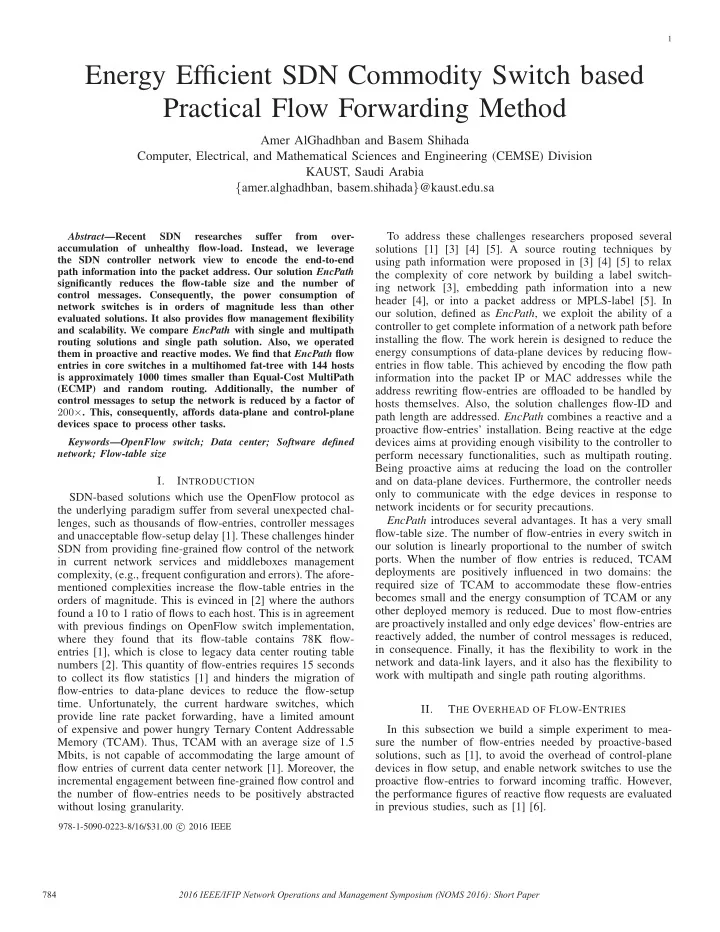

1 Energy Efficient SDN Commodity Switch based Practical Flow Forwarding Method Amer AlGhadhban and Basem Shihada Computer, Electrical, and Mathematical Sciences and Engineering (CEMSE) Division KAUST, Saudi Arabia { amer.alghadhban, basem.shihada } @kaust.edu.sa To address these challenges researchers proposed several Abstract —Recent SDN researches suffer from over- accumulation of unhealthy flow-load. Instead, we leverage solutions [1] [3] [4] [5]. A source routing techniques by the SDN controller network view to encode the end-to-end using path information were proposed in [3] [4] [5] to relax path information into the packet address. Our solution EncPath the complexity of core network by building a label switch- significantly reduces the flow-table size and the number of ing network [3], embedding path information into a new control messages. Consequently, the power consumption of header [4], or into a packet address or MPLS-label [5]. In network switches is in orders of magnitude less than other our solution, defined as EncPath , we exploit the ability of a evaluated solutions. It also provides flow management flexibility controller to get complete information of a network path before and scalability. We compare EncPath with single and multipath installing the flow. The work herein is designed to reduce the routing solutions and single path solution. Also, we operated energy consumptions of data-plane devices by reducing flow- them in proactive and reactive modes. We find that EncPath flow entries in flow table. This achieved by encoding the flow path entries in core switches in a multihomed fat-tree with 144 hosts is approximately 1000 times smaller than Equal-Cost MultiPath information into the packet IP or MAC addresses while the (ECMP) and random routing. Additionally, the number of address rewriting flow-entries are offloaded to be handled by control messages to setup the network is reduced by a factor of hosts themselves. Also, the solution challenges flow-ID and 200 × . This, consequently, affords data-plane and control-plane path length are addressed. EncPath combines a reactive and a devices space to process other tasks. proactive flow-entries’ installation. Being reactive at the edge devices aims at providing enough visibility to the controller to Keywords — OpenFlow switch; Data center; Software defined network; Flow-table size perform necessary functionalities, such as multipath routing. Being proactive aims at reducing the load on the controller I. I NTRODUCTION and on data-plane devices. Furthermore, the controller needs only to communicate with the edge devices in response to SDN-based solutions which use the OpenFlow protocol as network incidents or for security precautions. the underlying paradigm suffer from several unexpected chal- EncPath introduces several advantages. It has a very small lenges, such as thousands of flow-entries, controller messages flow-table size. The number of flow-entries in every switch in and unacceptable flow-setup delay [1]. These challenges hinder our solution is linearly proportional to the number of switch SDN from providing fine-grained flow control of the network ports. When the number of flow entries is reduced, TCAM in current network services and middleboxes management deployments are positively influenced in two domains: the complexity, (e.g., frequent configuration and errors). The afore- required size of TCAM to accommodate these flow-entries mentioned complexities increase the flow-table entries in the becomes small and the energy consumption of TCAM or any orders of magnitude. This is evinced in [2] where the authors other deployed memory is reduced. Due to most flow-entries found a 10 to 1 ratio of flows to each host. This is in agreement are proactively installed and only edge devices’ flow-entries are with previous findings on OpenFlow switch implementation, reactively added, the number of control messages is reduced, where they found that its flow-table contains 78K flow- in consequence. Finally, it has the flexibility to work in the entries [1], which is close to legacy data center routing table network and data-link layers, and it also has the flexibility to numbers [2]. This quantity of flow-entries requires 15 seconds work with multipath and single path routing algorithms. to collect its flow statistics [1] and hinders the migration of flow-entries to data-plane devices to reduce the flow-setup time. Unfortunately, the current hardware switches, which II. T HE O VERHEAD OF F LOW -E NTRIES provide line rate packet forwarding, have a limited amount of expensive and power hungry Ternary Content Addressable In this subsection we build a simple experiment to mea- Memory (TCAM). Thus, TCAM with an average size of 1.5 sure the number of flow-entries needed by proactive-based Mbits, is not capable of accommodating the large amount of solutions, such as [1], to avoid the overhead of control-plane flow entries of current data center network [1]. Moreover, the devices in flow setup, and enable network switches to use the incremental engagement between fine-grained flow control and proactive flow-entries to forward incoming traffic. However, the number of flow-entries needs to be positively abstracted the performance figures of reactive flow requests are evaluated without losing granularity. in previous studies, such as [1] [6]. 978-1-5090-0223-8/16/$31.00 c � 2016 IEEE 784 2016 IEEE/IFIP Network Operations and Management Symposium (NOMS 2016): Short Paper
Recommend
More recommend